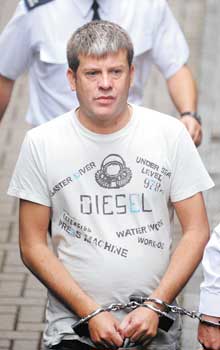
Brian Shivers, 44 anni, è comparso ieri nel tribunale di Ballymena, accusato per gli omicidi di Mark Quinsey e Patrick Azimkar, avvenuto all’esterno della caserma di Massereene, ad Antrim, lo scorso marzo.
L’uomo della contea di Derry è la seconda persona accusata per l’attacco rivendicato dalla Real IRA, nel quale altri tre soldati e i due fattorini che stavano consegnando le pizze sono rimasti feriti.
A marzo l’ex portavoce di Éirígí, Colin Duffy, è stato portato in tribunale con accusato dell’attacco di Antrim.
Un altro ex portavoce del gruppo repubblicano, Dominic Og McGlinchey, è stato interrogato dalla polizia e quindi rilasciato senza alcuna accusa.
Éirígí inizialmente ha negato che Shivers fosse uno dei suoi attivisti. Un portavoce del gruppo ha ammesso in seguito che Shivers faceva parte di Éirígí ma di aver presentato le proprie dimissioni a novembre, dopo soli sei mesi di appartenenza.
Le forze di sicurezza hanno contestato tale affermazione, rivelando che l’uomo agiva come “ufficiale addetto al reclutamento” fino ai mesi scorsi.
Shivers, di Sperrin Mews a Magherafelt, ha parlato solo una volta in tribunale, per confermare di aver compreso le accuse di omicidio, tentato omicidio e possesso di armi da fuoco e munizioni.
L’ispettore Justin Galloway ha detto che gli esperti della scientifica hanno recuperato il DNA di Shivers su un telefono cellulare e su due fiammiferi recuperati nella macchina usata per la fuga.
Niall Murphy, avvocato difensore, ha riferito che la prova è una copia di DNA a basso numero di copie, simile a quella screditata nel 2007 durante il processo per la bomba di Omagh.
“Questo è semplicemente DNA a basso numero di copie risistemato per opportunismo legale e scientifico”.
Galloway ha ammesso che gli esami iniziali sui fiammiferi non hanno dato sufficienti indizi per collegare Shivers alla scena. Gli scienziati hanno ottenuto un’identificazione positiva solo combinando i profili.
L’ispettore ha comunicato che gli esami sui fiammiferi hanno identificato il DNA di un’altra persone mentre sul telefono cellulare ci sarebbe DNA riconducibile a tre persone.
La polizia si è opposta al rilascio su cauzione, dicendo di temere per un’eventuale fuga del sospettato, come successo per un’altra persona.
Murphy ha affermato che il proprio cliente ha bisogno di cure ospedaliere per una fibrosi cistica quindi non potrebbe fuggire. Comunque Shivers è stato rimandato in custodia per ricomparire in tribunale in video conferenza il 18 agosto.
Tratto da Irish News
Barracks murders accused is ex-Eirigi
Brian Shivers (44) appeared before Ballymena Magistrates Court yesterday accused of murdering Mark Quinsey and Cengiz ‘Patrick’ Azimkar outside Massereene army barracks in Antrim in March.
The Co Derry man is the second person to be charged over the Real IRA attack in which three other soldiers and two pizza delivery men were also wounded.
In March prominent former eirigi spokesman Colin Duffy appeared in court charged with the murders.
Eirigi, a republican pressure group which is critical of Sinn Fein, distanced itself from the killings and claimed that Duffy had resigned two weeks earlier.
Another former eirigi spokes-man, Dominic Og McGlinchey, was also questioned about the attack but later released without charge.
Eirigi initially denied Shivers had been one of its activists. A spokes-man later admitted Shivers had been a member but said he had resigned last November after just six months with the organisation.
Security sources last night challenged that claim, saying he had operated as a “recruiting officer” for the group until recent months.
Shivers, of Sperrin Mews in Magherafelt, spoke in court only once, to confirm that he understood the charges of murder, attempted murder and possessing guns and ammunition with intent.
Detective Inspector Justin Galloway said forensic experts had recovered Shivers’s DNA on a mobile phone and two matches found in the getaway vehicle.
Niall Murphy, defending, said the forensic evidence was the same low-copy type discredited during the Omagh bombing trial in 2007.
“This is simply low-copy DNA which has been repackaged for legal and scientific expedience,” he said.
Mr Galloway admitted that initial tests on the matches had failed to provide strong enough evidence to link Shivers to the scene. Scientists only obtained a positive identification after combining the profiles.
He said tests on the matches had identified DNA from a second individual and tests on the phone had identified DNA from three people.
Police opposed bail, saying they feared another suspect had already fled the jurisdiction.
Mr Murphy said his client’s need for hospital treatment for cystic fibrosis meant he was not a flight risk. However, Shivers was remanded in custody to reappear in court via video-link on August 18.